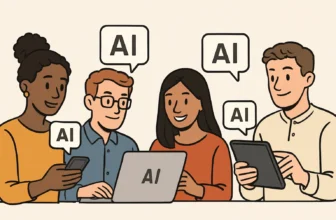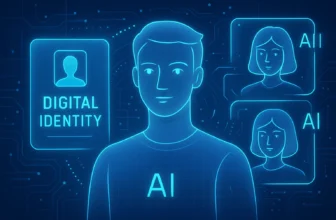
AI Revolutionizes Language Learning
Did you know that AI-powered language apps have helped more than 500 million people start learning a new language? Yep — and that number is climbing every day. What used to take hours of memorizing flashcards or sitting through boring grammar drills has now turned into bite-sized, interactive sessions you can do in your pajamas. Cool, right?
If you’ve ever tried picking up a second language, you know it can feel totally overwhelming. Trust me, I’ve been there — gritting my teeth through irregular verb lists and awkwardly mumbling at native speakers because I couldn’t remember a basic greeting. It’s frustrating. The old methods just…weren’t it.
But here’s the good news: AI is changing the whole game. And not in a sci-fi kind of way — in a super practical, personalized way that actually makes learning a new language fun (finally!).
So, how exactly is AI making language learning not suck?
- Instant feedback like a real tutor: Language apps such as Duolingo and Babbel now use AI algorithms to evaluate your pronunciation, grammar, and fluency on the spot. It’s like having a native speaker in your pocket — minus the awkward silences.
- Personalized lessons that get smarter over time: These apps don’t just throw random vocab at you — they learn from your mistakes. Struggled with prepositions? You’ll see more practice with those until you nail it.
- Conversational practice without judgment: Tools like AI chatbots (hello, ChatGPT!) let you practice real dialogues without the pressure. I once spent 30 minutes debating pizza toppings… in French. Oddly satisfying.
The best part? You don’t have to fly to Spain or sign up for a college course. All you need is your phone and maybe a few spare minutes during your morning coffee routine. You’re no longer chained to a textbook — you’re actually interacting with the language, and that makes all the difference.
Takeaway tip: Try pairing an AI-powered language app with an immersive practice habit. For example, spend 10 minutes chatting with an AI bot each day, and then watch a short TikTok or YouTube video in your target language. It’s fun, not scary — promise.
Language barriers are coming down, and it’s all thanks to AI. Whether you’re prepping for a semester abroad, plotting your next travel adventure, or geeking out over new dialects (hi, linguists!), this is your moment. So go ahead — open that app, speak that phrase, make that mistake.
You’re not just learning a language anymore. You’re connecting across cultures — and AI’s totally got your back.
Personalized Learning with AI
Did you know? People forget about 50% of new information an hour after learning it. Yep, half of it—*poof*—gone. Ugh, right?
If you’ve ever tried to learn a new language and felt like nothing sticks, you’re definitely not alone. I’ve been there—sweating over verb conjugations and silently cursing irregular nouns. It’s frustrating when traditional language apps or textbooks move too fast… or too slow. Either you’re bored to tears or overwhelmed and tempted to hit the “forget this” button. 😅
The struggle: One-size-fits-none?
One of the biggest problems with learning a new language the old-school way is that it treats every learner the same. It’s like going to a store where every single shirt is size “medium.” Great if you’re a textbook medium, but let’s be real—we all learn differently. Some of us blitz through vocab; others (hi, me 🙋♀️) take five tries just to pronounce “croissant” without sounding like a goose sneezing.
How AI saves the day (and your sanity)
Enter AI-powered apps—Duolingo, Babbel, and even newer players like Lingvist and Mondly. These aren’t just flashy interfaces with cute animations (though those definitely help). They’re shaped by machine learning, which means they watch how you learn and make smart changes based on your unique rhythm.
- Fail fast? Not a problem. Duolingo, for example, instantly adjusts difficulty based on your answers. Struggle with Spanish prepositions? It’ll subtly slip more practice into your routine—without making you feel like you’re being punished.
- Busy schedule? Babbel offers bite-sized lessons that remember what you’ve mastered and what needs reviewing. It’s like having your language BFF gently nudge your brain at just the right moments.
- Curious minds welcome. Apps now use spaced repetition and even predictive analytics to guess which words you’re about to forget. Creepy? Maybe. Effective? 100% yes.
Personally, I used to dread French lessons. They felt like a test I was slowly failing. But when I switched to an AI-driven app that customized my learning path, everything changed. Suddenly the app celebrated my tiny wins (“You nailed passé composé!” 🎉), gave me quick refreshers at just the right time, and let me skip things I already knew. Boom—instant motivation boost.
So, what can you do right now?
- Pick an adaptive app like Duolingo or Babbel if you haven’t already—and turn on learning notifications. Set realistic daily goals (5–10 minutes is fine!).
- Track your consistency, not just progress. AI thrives off patterns. Showing up every day helps the algorithm learn you better, and tailor lessons more closely to your abilities.
- Be honest with your pace. If you’re struggling, let the app know (most have feedback buttons or “Too hard/Too easy” options). No judgment, just smarter support headed your way.
Bottom line? AI is like the personal tutor you never knew you needed—except it never gets tired, forgets a lesson, or sighs dramatically when you botch German articles for the fifth time. With tech that adapts just for you, learning a language doesn’t have to feel like a random, uphill sprint. It’s your pace, your style, your path.
So… ready to actually enjoy learning a new language? Let AI be your guide—and watch your confidence (and vocab list) grow like crazy. 🌱
AI-Powered Language Practice
Did you know you’re more likely to stick with a new language if you practice speaking it for just **10 minutes a day**—and AI can be your partner-in-crime?
Now, if you’ve ever tried to learn a new language and hit a wall with textbook conversations like “The cat is on the table” (🙄), you are *so* not alone. We’ve all been there—flipping flashcards, repeating awkward phrases, and nervously googling how to say “where’s the bathroom?” five minutes before landing in a new country.
What’s missing? Real practice. Not just parroting vocab lists but actually *talking* like you would with a local at a café or a train station. Here’s where things get exciting: AI technology is completely flipping the script on how we learn to speak another language.
So, how is AI changing the game?
Enter the world of AI-powered chatbots and speech recognition tools. Trust me, these aren’t your clunky HTML bots from the early internet days. These are intelligent, responsive tools that simulate genuine conversations—slang, accents, and even tone included.
Let’s say you’re learning Spanish, and you want to practice ordering food. Boom! Fire up a chatbot like the one in Google’s AI Tutor on Android, and it *actually talks* to you like a native speaker, gives instant corrections, and suggests smoother ways to say things. Honestly, it’s like having a patient tutor in your pocket 24/7. No judgment, no awkward pauses, just regular convo vibes.
Ready to boost your fluency game?
- Try AI-driven language apps: Apps like Duolingo Max use powerful AI to simulate real-world chat scenarios, with characters that *actually* respond to what you say. It’s basically improv night for linguists.
- Practice your pronunciation with speech tools: Platforms like Elsa Speak or Speechling use AI to analyze your accent and give tailored feedback. Like a pronunciation mirror, but way less awkward.
- Turn your daily routine into language practice: Use tools like Google’s conversation prompts during walks, workouts, or while making coffee. I’ve personally replaced my podcast time with Spanish dialogues—and let me tell you, “coffee con leche” just hits different when you’re actually pronouncing it right!
Fun fact: According to a recent survey, students using AI chatbots for speaking practice improved their fluency scores 3x faster than those studying solo. Wild, right?
Final Thoughts: Talk like no one’s listening (because it’s just AI!)
The best part? You get to make mistakes in a totally safe space. No sweaty palms. No fear of sounding silly. Just you and this magical digital buddy helping you sound more like a local every day. It’s casual, low-key revolutionary, and totally within your reach.
So why wait for a trip abroad or the “perfect” classroom setting? Your language coach is literally in your pocket. And friendly warning: once you start chatting with AI bots, it’s kind of addicting. Fluency, here we come!
Breaking Cultural and Language Barriers
Did you know that over 7,000 languages are spoken around the world… but most apps focus on just 20? Wild, right? So what happens when we want to connect with someone outside that shortlist? That’s where AI steps in—not just as your personal tutor, but as a cultural guide, wing-person, and sometimes, conversation lifesaver.
We’ve all been there. You’re traveling, excited to explore a new place (hello, Tokyo ramen shop 🍜 or bustling Istanbul bazaar 🧿), and then—bam—you hit the “lost in translation” wall. You fumble for words, butcher pronunciations, awkwardly gesture, hoping they understand what you’re trying to say. Not fun. But also? A little exhilarating.
I’ve found that the *real* magic of AI in language learning isn’t just vocabulary drills or grammar checkers—it’s how it helps us not just speak, but *connect* with people, respectfully and meaningfully.
So, how exactly is AI helping us become global citizens?
- Real-time conversation tools: Apps like Google Translate and iTranslate are stepping up big. But newer players—think Timekettle earbuds—offer real-time translations that actually sound natural. Like you’re genuinely chatting, not just parroting phrases.
- Cultural context learning: AI can now flag when you’re being “technically correct but culturally awkward.” Apps like FluentU or Immerse use real-world videos to show language in context—facial expressions, tone shifts, local slang. You learn to speak like people *actually* do.
- Adaptive learning paths: Tools like Duolingo or Babbel (if you haven’t checked them lately—oh wow, they’ve evolved!) adjust based on your strengths and weaknesses. So it’s not just “learn French,” it’s “learn French *as spoken in Senegal* if that’s where you’re headed.” Super useful.
Here’s a mini story: A friend of mine went to Seoul with just a few Korean phrases under her belt. She used an AI conversation app—not only did it help her navigate the city, but it also helped her bond with a local shop owner over shared love for K-dramas (yes, *Crash Landing on You* fans unite!). That small connection? Made her whole trip.
What’s surprising is how these tools go beyond speaking—they’re helping create empathy. A shared laugh over mispronouncing a word. An “ahh” moment when someone realizes you’ve made the effort to learn their language, even a little. AI helps make those happen more often—and less awkwardly.
Actionable tips to connect across cultures using AI:
- Pair language learning with cultural deep dives: Use AI to explore customs, body language, even humor. Try asking ChatGPT how to greet someone in Brazil vs. Japan—totally different vibes!
- Practice real conversations, not just flashcard vocab: Use apps with dialogue simulators or even AI tutors to role-play actual scenarios—ordering food, asking directions, or just chatting about hobbies.
- Lean into “messy learning”: Use AI to get feedback when you’re unsure. Mispronounced something? Messed up the context? Great. That’s how we grow.
Bottom line? Language apps aren’t just tools—they’re bridges. AI is helping tear down walls between “us” and “them,” turning the whole world into one big, fascinating conversation. And every “hello,” even if it’s mispronounced at first, brings you one step closer to understanding—and being understood.
So next time you open a language app, don’t just think study mode. Think connection. Think adventure. You’ve got a whole world waiting. 🌍💬
Future Trends in AI and Language Learning
Did you know? By next year, over 50% of learners say they’d prefer virtual reality (VR) environments over traditional classrooms for picking up a new language. Wild, right? But honestly… can you blame them?
Let’s be real—we’ve all tried to cram vocabulary with flashcards or slog through grammar drills that feel like pure brain fog. I’ve been there, obsessively repeating “la pomme” at 11 PM trying to sound remotely French. But something’s changing. Fast. The way we learn languages is starting to look less like textbooks and more like stepping into another world—literally.
This is where things get really exciting: AI and virtual reality are teaming up. And it’s about to totally shake up how we learn to communicate across languages and cultures.
So what’s around the corner?
- Immersive VR Language Labs: Imagine slipping on a VR headset and suddenly you’re ordering gelato from a vendor in Rome or haggling at a street market in Mexico City. No passport needed. This kind of full sensory immersion helps your brain learn as if you’re really there. Total game changer.
- Real-Time AI Translation Coaches: Think Siri meets Duolingo, but way smarter. These new AI tools will analyze not just your words, but your tone, pacing, and pronunciation—then give you feedback instantly, like a super chill tutor who never needs a coffee break.
- Emotionally Intelligent Language Apps: Yep, AI is getting feelings. New platforms are being trained to understand your emotional state—so they can adapt and motivate you when you’re feeling stuck or bored. I personally tried one that sensed when I was losing steam and switched things up with a roleplay game and jokes in Spanish. I ended up practicing for an extra hour without even noticing. Go figure!
How can you ride this wave right now?
Don’t just wait for the future—dip your toes in now:
- Try VR learning platforms like Immerse or Mondly VR. They let you engage with native speakers (avatars, but still!) in real situations.
- Explore AI-powered chatbots that help you practice conversations. Tools like ChatGPT with language-specific prompts or TalkPal simulate chat with a friendly native speaker.
- Set a “techy” language goal. For example, commit to 10 minutes daily in a VR café setting, or using an AI pronunciation tool like Elsa Speak before breakfast. Make it fun—think mini adventures!
Looking ahead
We’re not just learning languages—we’re about to live them. And that means clearer conversations when traveling, deeper appreciation of new cultures, and a major confidence boost.
AI won’t replace human language, but it’s making learning more personal, intuitive, and—dare I say—fun? So, whether you’re brushing up before a backpacking trip or studying for a linguistics exam, know this: the future is bright… and multilingual.
Your move? Dive in now, let AI be your travel buddy, tutor, and cheerleader all in one. Bon voyage!
Embrace the AI-Powered Linguistic Future
Did you know that over 7,000 languages are spoken around the world, yet only a fraction of them are accessible through traditional learning platforms? I mean, imagine planning a solo trip to rural Vietnam and realizing Duolingo won’t quite get you fluent in the local dialect. Frustrating, right?
Here’s the thing: language has always been a beautiful bridge between cultures, but for so long, it’s also been a giant stumbling block—especially for travelers just trying to order lunch without accidentally asking for… well, something totally embarrassing. I’ve been there. I once asked a waiter in Spain where the bathroom “tastes” instead of where it “is.” Safe to say he still remembers me.
Enter AI-powered language tools, and boom—game changer.
For students, these tools turn boring vocab drills into interactive conversations. For travelers, they offer instant translation, cultural context, even help you nail that accent (looking at you, French rs). And for linguists? The possibilities are straight-up thrilling. We’re talking real-time transcription, deep learning of dialects, and tools that adapt to your personal learning style like a virtual tutor that actually *gets* you.
So how do you hop on this AI-powered language train?
- Start with smart apps: Platforms like Memrise, ChatGPT plugins, and Speechling use AI to tailor lessons, practice pronunciation, and quiz you based on how you learn best.
- Use real-time translation tools: Apps like Google Lens and DeepL aren’t just for translating menus—they can help you learn by showing you how sentences are structured in different contexts.
- Talk to AI like you’re talking to a friend: It’s wild, but you can literally have full-on conversations with chatbots fluent in dozens of languages. It’s like tandem learning without awkward scheduling.
I’ve personally been using AI tutors for Spanish, and let me tell you, it’s worlds better than my old flashcard routine. The bot corrects my conjugations in real-time, suggests better phrasing, and even compliments me when I get something right. (I know it’s a bot, but hey, who doesn’t love a gold star?)
The best part? These tools are getting better every day, which means learning languages is more accessible than ever. No more gatekeeping, no more unaffordable tutors or awkward classroom recitations. Just you, a curious mind, and a tech-powered path to fluency.
So, are you ready to ditch the fear and embrace the future? Whether you’re prepping for study abroad, gearing up for your next vacation, or just itching to dive deeper into languages you love—AI is your new best study buddy. Go ahead, pick a language, download a tool, start chatting with an AI in Portuguese or Mandarin (you got this!).
The world’s waiting—and now, thanks to AI, you’re finally fluent in saying hello.












